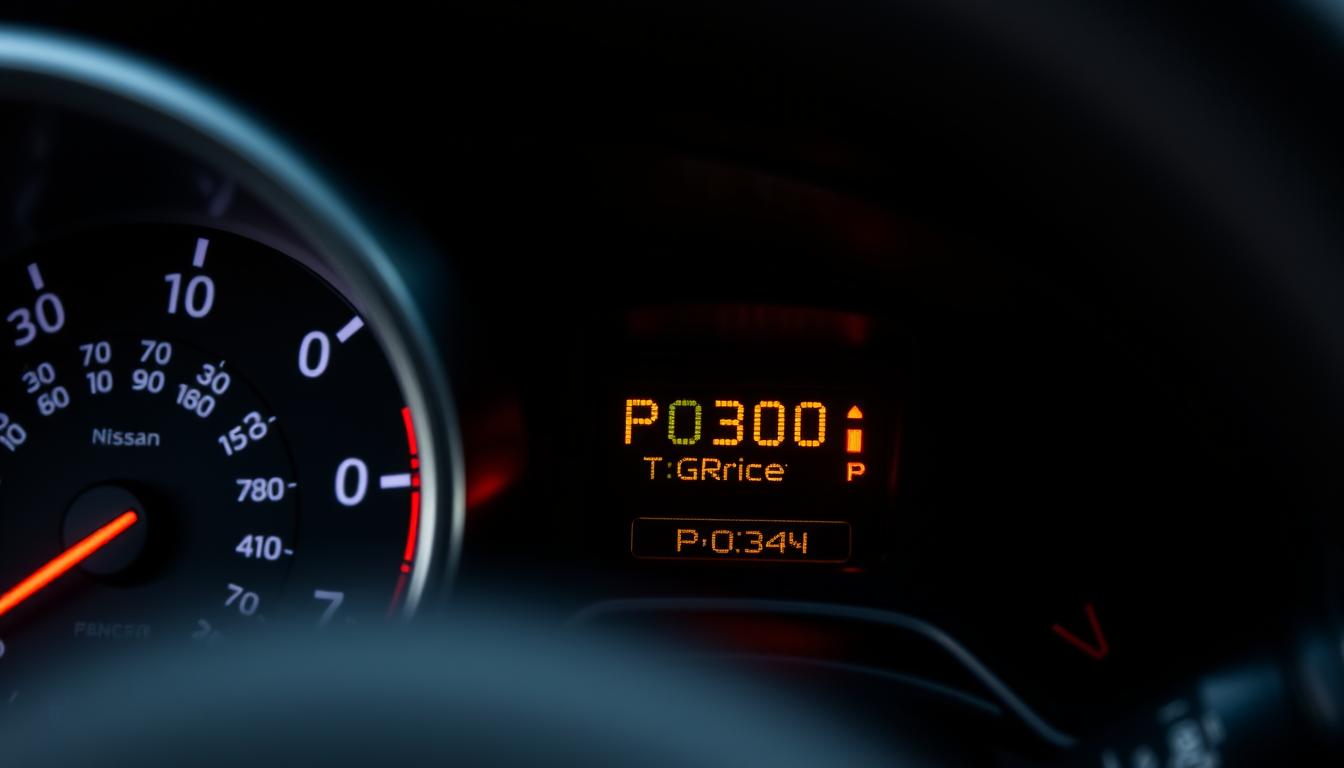The P0300 code means there’s a random misfire in one or more engine cylinders in Nissan cars. This often turns on the check engine light. If you see the check engine light on while driving your Nissan, it can be scary.
Many things can cause a random misfire, like bad ignition parts or fuel system problems. Knowing about the PO300 code is key for Nissan owners. It’s important because it can hurt your car’s performance and lifespan, and it might make the check engine light come on.
Fixing the PO300 code is vital to avoid engine damage and keep your car running well. Mechanics can find and fix the problem. They use tools like code scanners and check the ignition and fuel systems to find the cause of the check engine light.
Key Takeaways
- The PO300 code indicates a random misfire in one or more cylinders of the engine in Nissan vehicles.
- The check engine light can be triggered by the PO300 code Nissan issue.
- Faulty ignition system components or fuel system issues can cause the PO300 code.
- Understanding the PO300 code is crucial for Nissan vehicle owners to prevent further damage to the engine.
- Professional mechanics can diagnose and repair the PO300 code Nissan problem using a diagnostic process.
- Resolving the PO300 code issue is essential to ensure optimal vehicle performance and longevity, and to prevent the check engine light from illuminating.
Understanding the PO300 Code in Nissan Vehicles
The PO300 code means your Nissan’s engine is misfiring in one or more cylinders. It’s important to fix this quickly to avoid more engine performance issues.
Definition of PO300 Code
The P0300 code shows a Nissan misfire without pointing to a single cylinder. It means many cylinders are misfiring in a random way. This messes up how the engine works.
Why This Code Appears in Nissan Models
- Faulty ignition systems, such as damaged spark plug wires or faulty ignition coils
- Fuel system issues, including clogged fuel filters or malfunctioning injectors
- Vacuum leaks from cracked hoses or faulty intake manifold gaskets
- Mechanical problems like worn piston rings or damaged timing belts
- Electrical issues, including a faulty engine control module (ECM)
Impact on Vehicle Performance
A Nissan misfire can really hurt your engine’s performance. You might see less power, worse fuel efficiency, and more emissions. If not fixed, it could damage your engine even more.
Common Symptoms Associated with PO300 Code
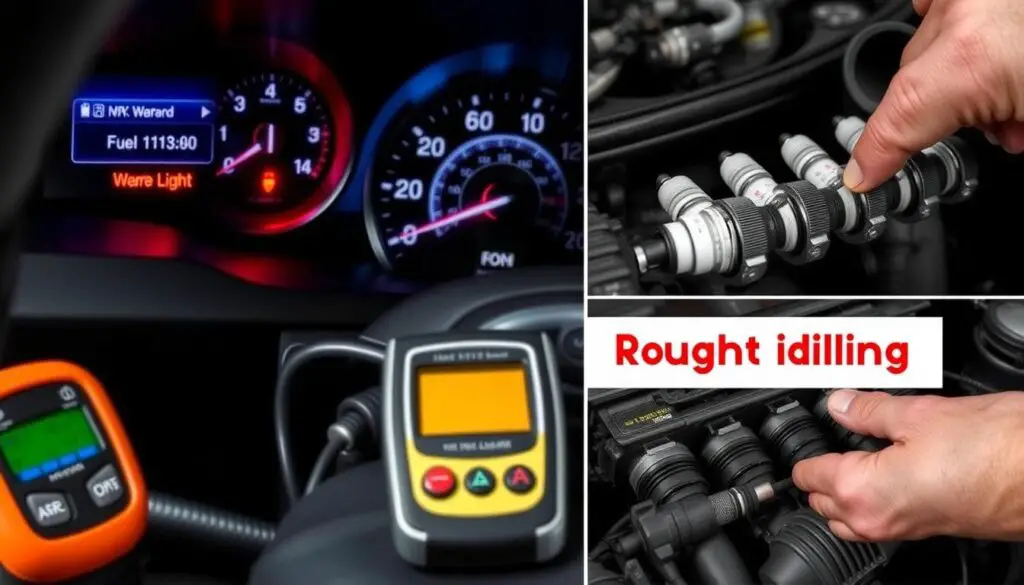
Unexpected engine vibration can signal problems linked to the PO300 code. When many cylinders misfire, the engine shakes. This happens because it runs unevenly.
- Reduced Power: You might notice a significant drop in your vehicle’s performance, making acceleration sluggish.
- Decreased Fuel Efficiency: Misfires can lead to incomplete combustion, resulting in higher fuel consumption.
- Flashing Check Engine Light: A rapidly blinking check engine light indicates a more severe issue that requires immediate attention.
- Unusual Exhaust Odors: Strong smells of fuel can emanate from the exhaust due to unburnt fuel from misfires.
These symptoms can vary in intensity. For instance, engine roughness might be mild initially but can escalate to complete loss of power if not addressed. Recognizing these signs early is crucial for implementing effective troubleshooting solutions outlined in a comprehensive Nissan repair guide. Prompt action helps prevent further damage and ensures the longevity of your vehicle.
Main Causes of PO300 Code in Nissan Cars
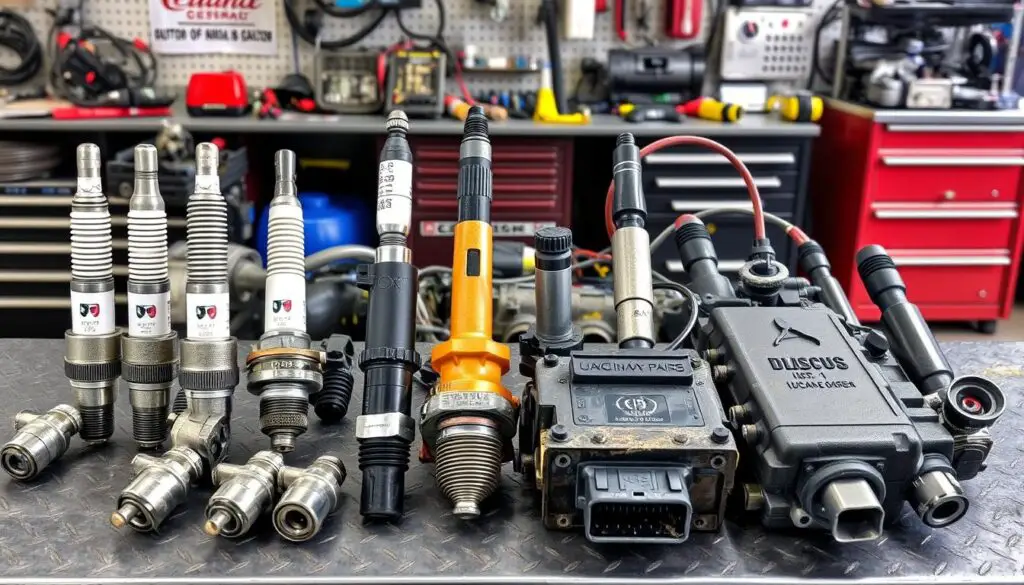
The common causes of the PO300 code in Nissan vehicles can lead to significant engine misfires. Understanding these issues is essential to fix PO300 code effectively.
Faulty Spark Plugs
Worn or damaged spark plugs disrupt the engine’s combustion process, causing random misfires. Regular maintenance can prevent this issue.
Ignition Coil Issues
Defective ignition coils fail to provide the necessary spark, leading to inconsistent engine performance and triggering the PO300 code.
Fuel System Problems
Clogged fuel injectors or a malfunctioning fuel pump can result in improper fuel delivery, contributing to engine misfires.
Engine Timing Concerns
Incorrect engine timing affects the synchronization of engine components, which can cause misfires and activate the PO300 code.
How to Diagnose PO300 Code in Your Nissan
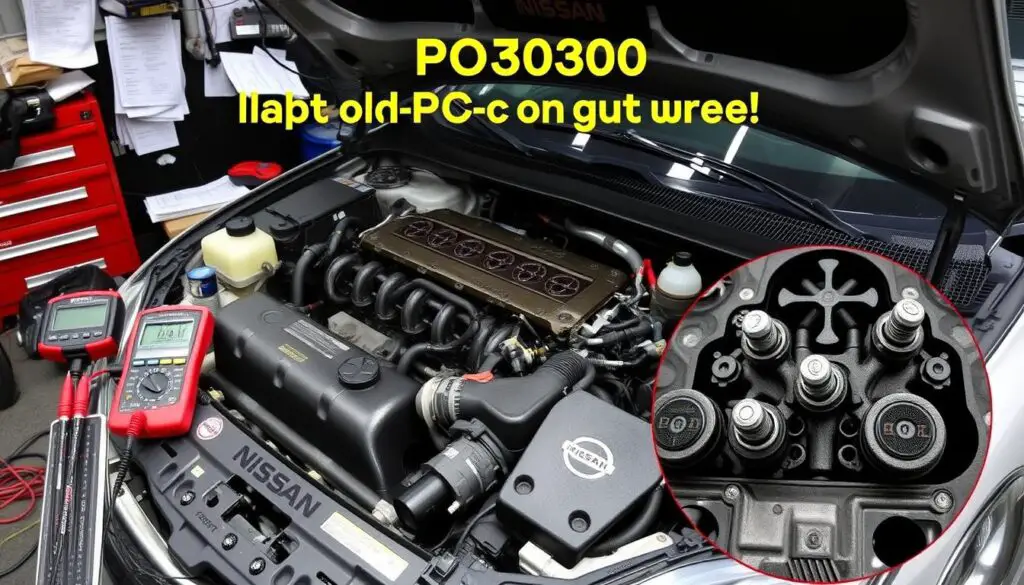
To find the cause of the PO300 code in your Nissan, start by using an OBD-II scanner. This tool helps you get error codes from your car’s computer.
- Scan for Codes: Plug the OBD-II scanner into your car’s diagnostic port. It will show you the PO300 code and any other related codes.
- Visual Inspection: Look at the ignition system parts like spark plugs and ignition coils. Check for wear or damage.
- Check the Fuel System: Make sure fuel injectors and fuel pressure are working right. This ensures the engine gets the right amount of fuel.
- Perform a Compression Test: This test checks if there are mechanical problems in the engine’s cylinders.
- Examine the Electrical System: Search for any bad wiring or connectors that might mess with the engine’s performance.
- Make sure all connections are tight and clean.
- Look for vacuum leaks that could mess with the air-fuel mix.
- Check if the engine timing is correct.
By following these diagnostic tips, you can find out why you have the PO300 code. If you can’t figure it out, it’s best to get help from a professional mechanic. They can offer more advanced troubleshooting solutions.
| Diagnostic Step | Description | Troubleshooting Solution |
|---|---|---|
| Scan for Codes | Use an OBD-II scanner to get error codes. | Find out what specific problems the PO300 code is linked to. |
| Visual Inspection | Look for damage on ignition parts. | Replace any bad spark plugs or ignition coils. |
| Fuel System Check | Check fuel injectors and pressure. | Fix or replace fuel injectors if needed. |
| Compression Test | Test the engine’s cylinder compression. | Fix mechanical problems if compression is low. |
| Electrical System Examination | Check the wiring and connectors. | Repair or replace any faulty electrical parts. |
Essential Tools for PO300 Diagnostics
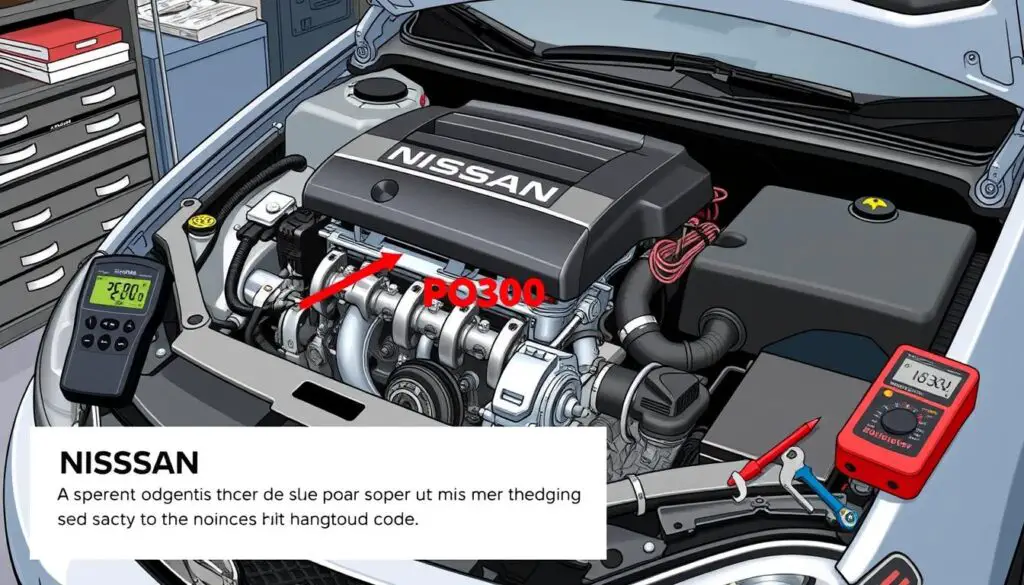
To diagnose the PO300 code in your Nissan, you need the right tools. A good Nissan repair guide stresses the need for reliable equipment. This ensures you get accurate results.
OBD-II Scanner Requirements
A quality OBD-II scanner is key for reading the PO300 code and other diagnostic codes. Look for a scanner that offers real-time data and works with many vehicles. It should also be easy to use. Tools like the BlueDriver scan tool give detailed diagnostics and access to Mode $06 data, making diagnosis better.
Additional Diagnostic Equipment
There are more tools to help diagnose the PO300 code:
- Multimeter: Great for checking electrical connections and voltage levels.
- Compression Tester: Helps find engine compression issues.
- Fuel Pressure Gauge: Important for checking the fuel system’s performance.
Using these tools well can give you detailed diagnostic help. This ensures you find and fix the PO300 code’s root cause.
Step-by-Step Diagnostic Process
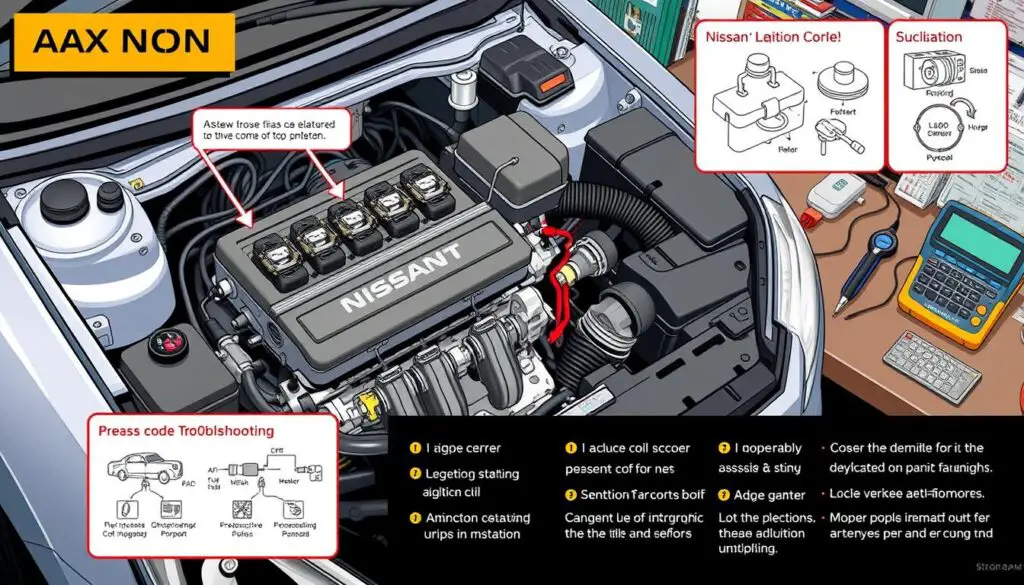
Fixing the P0300 code in your Nissan needs a careful plan. Here are the steps to find and fix the problem:
- Scan for Codes: First, use an OBD-II scanner to find error codes. This step helps you know where to start.
- Visual Inspection: Look at spark plugs, ignition coils, and wiring for damage or wear.
- Ignition System Check: Test the ignition coils and spark plug wires to make sure they work right.
- Inspect Fuel System: Check the fuel injectors for blockages and the fuel pump’s pressure.
- Perform Compression Test: Check the engine’s compression to find any internal problems.
- Check Electrical System: Look at sensors and wiring for the engine’s electrical system for any issues.
By following these steps, you can find and fix the problem. This will make your vehicle run smoothly again.
| Diagnostic Step | What to Check | Troubleshooting Solutions |
|---|---|---|
| Scan for Codes | Retrieve and interpret error codes | Use a reliable OBD-II scanner to identify specific issues |
| Visual Inspection | Check spark plugs and ignition coils | Replace any damaged or worn components |
| Ignition System Check | Test ignition coils and wires | Ensure all connections are secure and functional |
| Inspect Fuel System | Assess fuel injectors and pump pressure | Clean or replace clogged injectors; repair fuel pump as needed |
| Perform Compression Test | Measure engine compression levels | Address any cylinder compression issues |
| Check Electrical System | Inspect engine sensors and wiring | Repair or replace faulty sensors and wiring |
Common Mistakes When Diagnosing PO300 Codes
Getting a Nissan misfire right is key. But, many mistakes can mess up repairs.
Overlooked Symptoms
Ignoring small signs of trouble is a big mistake. Things like a car idling badly or shaking can be clues. Not catching these can hide the real problem.
Misinterpretation of Results
Reading diagnostic tool results wrong is another error. Without knowing what you’re looking at, you might fix the wrong thing. It’s important to understand OBD-II scanner data to fix the misfire right.
Professional vs. DIY Repair Considerations
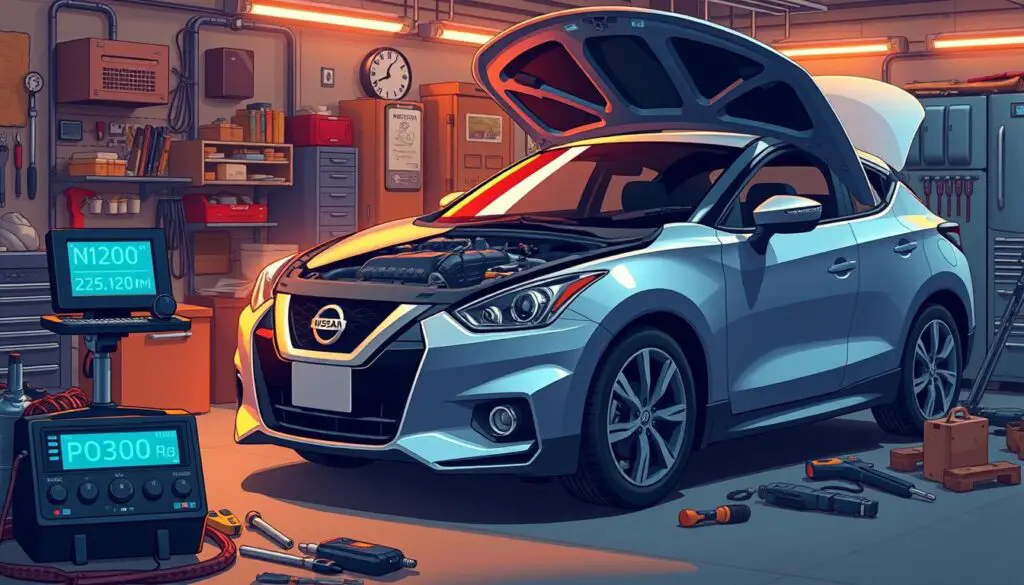
Choosing between professional help or DIY repair is key when you need a Nissan repair guide for PO300 code. Simple tasks like replacing spark plugs are doable for those with basic tools and knowledge.
But, for complex issues like ignition coil problems or fuel system repairs, getting professional help is best. Experts have the skills and tools needed to fix these problems right, making sure your car runs well.
- Technical complexity of the repair
- Availability of necessary tools
- Potential risks involved
- Cost-effectiveness of DIY versus professional service
A Nissan repair guide can give you step-by-step instructions for some fixes. But, knowing your limits is crucial. Trying complex repairs without the right knowledge can cause more harm. So, it’s often safer to go for professional services to fix PO300 code right.
Cost Implications of PO300 Repairs
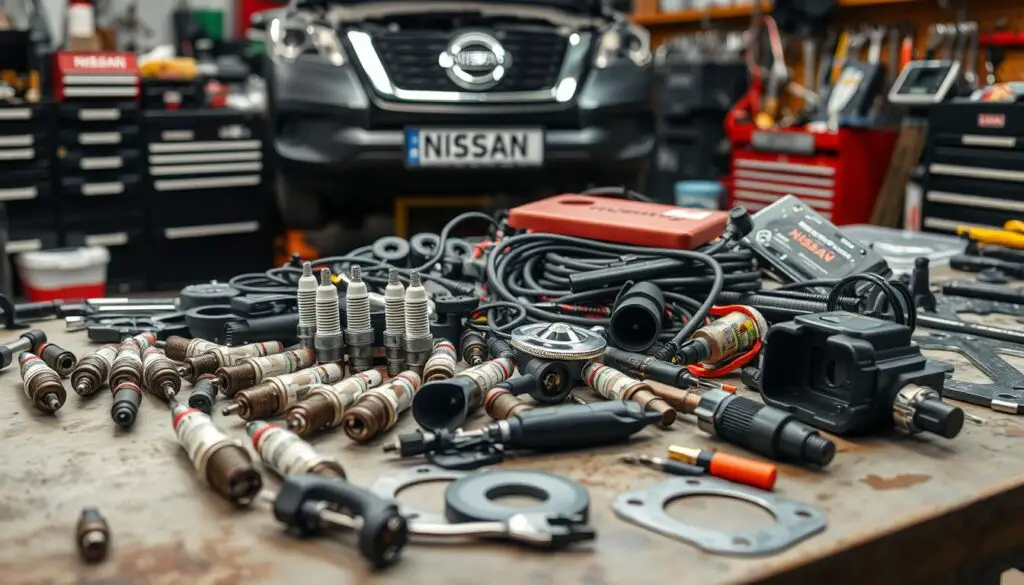
Understanding the costs of fixing a Nissan with the PO300 code is key. This helps you get ready for the repairs. Let’s look at the main cost factors.
Parts Pricing Overview
The price of parts changes based on what’s needed to fix the PO300 code. You might need spark plugs, ignition coils, or fuel system parts. On average, these parts cost between $50 to $300. This depends on the quality and brand.
Labor Cost Estimates
Labor costs vary with the repair’s complexity and the mechanic’s rate. Fixing the PO300 code usually takes 1 to 3 hours. Labor rates are $75 to $150 per hour. So, labor can cost between $75 and $450.
Insurance Coverage Possibilities
Some insurance might cover the PO300 code repair costs. This is more likely if it’s due to a mechanical failure covered by your policy. Always check with your insurance to see what’s covered and what you might have to pay.
Preventing Future PO300 Codes
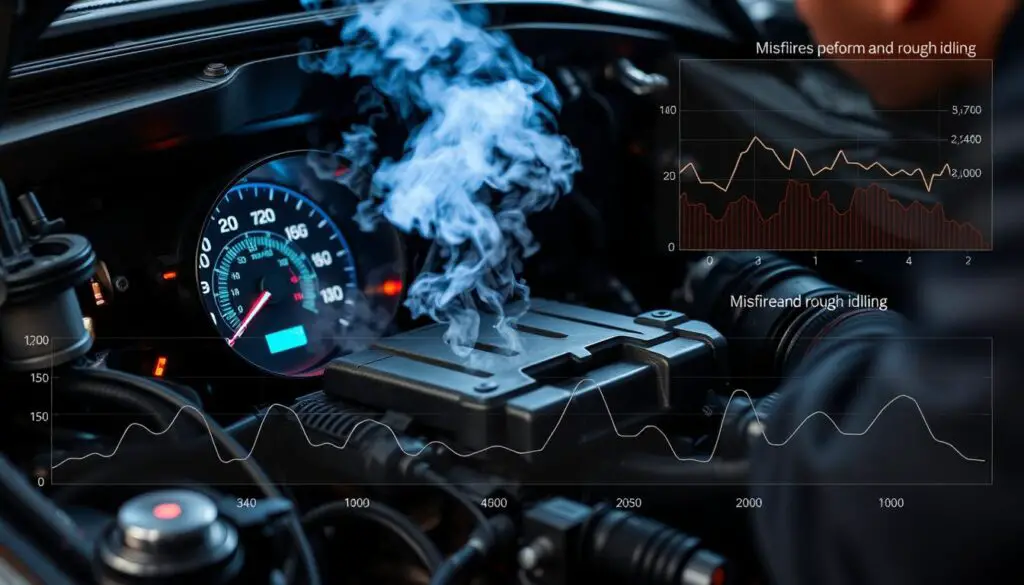
Keeping your Nissan’s engine in top shape is key to avoiding the PO300 code. Regular care helps keep your car running well. This means fewer engine performance issues.
Good driving habits are also important. Try to avoid sudden starts and make sure the engine gets warm before driving. This helps reduce wear on parts.
Here are some important steps to take:
- Regular Maintenance: Make sure to check spark plugs, ignition coils, and fuel injectors regularly.
- Quality Parts: Use parts that the manufacturer recommends. They last longer and work better.
- Monitor Performance: Watch for any changes in how your engine runs. This could be things like a rough idle or less power.
- Timely Repairs: Fix small problems right away. This stops them from getting worse and costing more to fix.
By following these tips, you can solve troubleshooting solutions and keep your engine running well.
| Preventative Measure | Benefit |
|---|---|
| Regular Maintenance | Prevents wear and tear of engine components |
| Quality Parts | Ensures reliable performance and reduces failure rates |
| Monitor Performance | Early detection of potential issues |
| Timely Repairs | Avoids costly repairs and extends engine life |
Impact on Vehicle Safety and Emissions
Engine problems trigger the check engine light, showing issues that can harm safety. Misfires from the PO300 code make the engine less responsive. This can be dangerous during important driving moments.
Safety Considerations
The check engine light coming on means misfires, which can make the vehicle act strangely. This might make braking and accelerating less effective. It also makes handling worse, raising the chance of accidents.
Environmental Impact
Engine problems are not just a safety risk but also harm the environment. Misfires lead to more pollutants like carbon monoxide and hydrocarbons. These pollutants pollute the air and can cause the vehicle to fail emissions tests.
Model-Specific PO300 Issues
The PO300 code Nissan is a problem for many Nissan models. Knowing the specific issues for each model helps fix Nissan misfire problems.
Common Problems by Nissan Model
- Sentra: Frequent misfires due to faulty ignition coils.
- Altima: Engine timing issues leading to the PO300 code.
- Maxima: Fuel system inconsistencies causing misfires.
- Rogue: Spark plug failures triggering the error code.
Year-Specific Concerns
- 2015-2017 Models: Susceptible to ignition module defects.
- 2018-2020 Models: Updated fuel injectors may malfunction under certain conditions.
- 2021-Present Models: Advanced engine timing systems can experience software glitches affecting performance.
Fixing these PO300 code Nissan issues quickly keeps your Nissan running well. Regular checks and quick fixes help avoid ongoing Nissan misfire issues.
Long-term Effects of Ignoring PO300 Code
Ignoring the PO300 code in your Nissan can cause many engine performance issues. Misfires can wear down engine parts, leading to serious damage over time.
- Engine Damage: Continuous misfires can damage the catalytic converter and pistons.
- Decreased Fuel Efficiency: An inefficient engine uses more fuel, raising costs.
- Higher Repair Costs: Small problems can turn into big, expensive repairs.
- Reduced Vehicle Lifespan: Not fixing early signs can shorten your Nissan’s life.
It’s important to fix the PO300 code quickly. Using a detailed Nissan repair guide helps you act fast. This prevents more problems and keeps your vehicle running well.
| Effect | Severity | Impact |
|---|---|---|
| Engine Damage | High | Requires extensive repairs or engine replacement |
| Decreased Fuel Efficiency | Medium | Increased fuel costs over time |
| Higher Repair Costs | High | Unexpected financial burden |
| Reduced Vehicle Lifespan | Medium | Shortened use before needing a new vehicle |
When to Seek Professional Help
Some troubleshooting solutions for the P0300 code can be done at home. But, there are times when you need a pro. Knowing when to get help can save you time and avoid bigger problems.
Emergency Situations
If your car suddenly loses power, stalls, or shows warning lights, get help fast. These signs could mean a serious engine issue that’s dangerous.
Warranty Considerations
Before fixing anything, check if your car is still under warranty. Fixing it under warranty can save you a lot of money. A good Nissan repair guide can tell you if the problem is covered. This way, you can fix things without losing your warranty.
| Situation | Action |
|---|---|
| Severe engine symptoms (e.g., stalling) | Seek immediate professional help |
| P0300 code persists after DIY repairs | Consult a qualified mechanic for further diagnosis |
| Vehicle under warranty | Use warranty services to address the issue |
| Uncertainty about the problem | Refer to a troubleshooting solutions expert |
Conclusion
The PO300 code Nissan might seem scary at first, but it’s not too hard to understand. Finding problems like bad spark plugs or ignition coils can help fix it. You can either do it yourself or get help from a pro.
Regular car care is key to avoiding PO300 codes in the future. Keeping your engine parts in top shape helps your car run better. Using tools like BlueDriver can also help you catch issues early.
With the tips from this guide, Nissan owners can handle PO300 code problems easily. Being proactive not only makes your car more reliable but also saves fuel. Stay on top of your Nissan’s health by fixing PO300 code issues quickly and right.
FAQ
What is the P0300 code in Nissan vehicles?
What are the common causes of the P0300 code in Nissan cars?
What symptoms should I look for if my Nissan has a P0300 code?
How much does it typically cost to repair the P0300 code in a Nissan?
Can I fix the P0300 code myself, or should I seek professional help?
What tools do I need to diagnose the P0300 code in my Nissan?
How does the P0300 code affect my Nissan’s engine performance?
What are the long-term effects of ignoring the P0300 code in my Nissan?
How can I prevent the P0300 code from appearing in my Nissan?
What are common mistakes to avoid when diagnosing the P0300 code in a Nissan?
How does the P0300 code impact vehicle safety and emissions?
Are there specific Nissan models or years that are more prone to the P0300 code?
When should I seek professional assistance for the P0300 code in my Nissan?

Jack Thompson is a writer and seasoned auto mechanic with over 15 years of experience in the automotive industry. Known for his expertise in vehicle mechanics, Jack has a deep understanding of car and truck systems. His skills, honed through years of hands-on experience, have made him a trusted name in the field. Jack is committed to providing valuable insights into car maintenance and repair, helping vehicle owners keep their vehicles in top condition.

